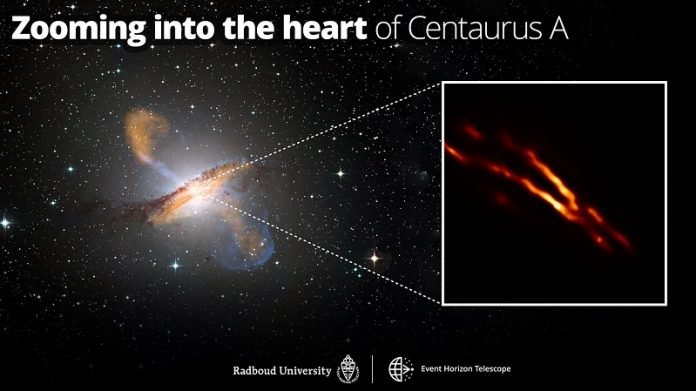
Scientists anchored by the Event Horizon Telescope Collaboration, which is known for capturing the first image of a black hole in the galaxy Messier 87, have now imaged the heart of the nearby radio galaxy Centaurus A in unprecedented detail.
The astronomers pinpoint the location of the central supermassive black hole and reveal how a gigantic jet is being born.
Most remarkably, only the outer edges of the jet seem to emit radiation, which challenges our theoretical models of jets.
“This allows us for the first time to see and study an extragalactic radio jet on scales smaller than the distance light travels in one day.
We see up close and personally how a monstrously gigantic jet launched by a supermassive black hole is being born,” said astronomer Michael Janssen of the Max Planck Institute for Radio Astronomy in Bonn and Radboud University Nijmegen, who led the study, published in Nature Astronomy.
Understanding jets
Bright objects in the sky, like stars and galaxies, emit light in multiple wavelengths—including radio wavelengths—and each can tell us different things.
When you look at the night sky at radio wavelengths, the nearby galaxy Centaurus A emerges as one of the largest and brightest objects.
At the center of Centaurus A lies a black hole with a mass equal to 55 million of our suns.
That’s right between the masses of the Messier 87 black hole that we saw in the famous original image (which is six and a half billion suns), and the one in the center of our own galaxy (about four million suns).
These supermassive black holes are feeding off gas and dust attracted by their enormous gravitational pull. This process releases massive amounts of energy and the galaxy is said to become “active.”
Most matter lying close to the edge of the black hole falls in. However, some of the surrounding particles escape moments before capture and are blown far out into space in a phenomenon called a jet—one of the most mysterious and energetic features of galaxies.
Astronomers have relied on different models of how matter behaves near the black hole to better understand this process.
But they still do not know exactly how jets are launched from its central region, and how they can extend over scales that are larger than their host galaxies without dispersing out.
The new image shows that the jet launched by Centaurus A is brighter at the edges compared to the center. This phenomenon is known from other jets, but has never been seen so pronouncedly before.
“Now we are able to rule out theoretical jet models that are unable to reproduce this edge-brightening. It’s a striking feature that will help us better understand jets produced by black holes,” said co-author Matthias Kadler, TANAMI leader and professor for astrophysics at the University of Würzburg in Germany.
Very long interferometry
To observe the Centaurus A galaxy with this unprecedentedly sharp resolution, the collaboration used a technique called Very Long Baseline Interferometry, the same technique with which the famous image of the black hole in M87 was made.
An alliance of eight telescopes around the world joined together to create the virtual “Earth-sized” Event Horizon Telescope.
One of them was the South Pole Telescope, run by an international collaboration led by the University of Chicago. Normally it spends its time surveying the faint light left over from the Big Bang, but its unique position in Antarctica helped the Event Horizon Telescope in its quest to expand its scope around Earth.
“We’re pleased that the South Pole Telescope is able to play a key role in the Event Horizon Telescope’s reach around the globe as it continues to push the boundaries of what’s possible with this technique,” said John Carlstrom, the director of the South Pole Telescope and the Subramanyan Chandrasekhar Distinguished Service Professor at the University of Chicago.
“This is the result of a lot of work from a lot of people, and it’s wonderful to see such interesting science results beginning to come out.”
With the new EHT observations of the Centaurus A jet, the likely location of the black hole has been identified at the launching point of the jet.
Based on this location, the researchers predict that future observations at an even shorter wavelength and higher resolution would be able to photograph the central black hole of Centaurus A. This will require the use of space-based satellite observatories.
The EHT collaboration involves more than 300 researchers from Africa, Asia, Europe, North and South America.



